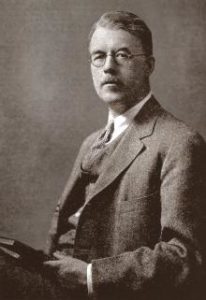Innovative from the Beginning
Dearborn Academy was founded in the 1940s as the first of Lesley University’s “home-grown” lab schools, known as the Cambridge Town School, and focused on what it really means to learn – especially when a child learns in a different way.
One of the earliest pioneers in the field of reading was Walter Fenno Dearborn for whom the school is named. Dearborn, a Harvard University researcher in psychology and education, was the first scientist to realize that children with what we now call dyslexia were as intelligent and capable as children who had no trouble reading. What these students needed were simply different strategies for learning to read.
After retiring from Harvard, Dearborn became head of Lesley University’s educational psychology program. His work at the lab school helped him refine his theory of reading, develop highly effective strategies for overcoming reading challenges, and train hundreds of new teachers in these techniques.
Over the next three decades, Dearborn Academy grew to include three schools: the Carroll-Hall School (1957), the Dearborn Pre-Vocational Program (1970) and the Dearborn Secondary Program (1978). In 1981 Lesley University voted to divest itself from its lab schools, and these assorted schools came under the management of the newly formed nonprofit organization, Schools for Children. In 1990, they were consolidated into a single entity, Dearborn Academy.
Responding to Students’ Needs
In the 1990s, Dearborn began to share its approach with other schools, including schools with typical learners. That same year the school also started consultation services. Dearborn teachers and administrators visited school districts across the state to share their knowledge and teaching techniques. These consulting relationships helped Dearborn become known for more than its innovative reading approach.
As time went on, Dearborn expanded beyond its expertise in reading and began to serve students presenting with communication, mental health and behavioral difficulties. While continuing to help students with specific learning difficulties in reading, Dearborn also developed programming that supports specific learning disabilities in math, communication difficulties and social pragmatics.
Dearborn also expanded its elective offerings to provide more opportunities for students to have a hands-on approach to learning, expand their felt sense of competency and increase their perseverance when trying new things. Woodworking, metal shop, jewelry making and technology offered more opportunities for students to express themselves and uncover new interests and talents. With this new breadth of services, Dearborn increased the diversity of learners in its community.
In the past few years, Dearborn has continued to change and fine-tune its programming. Dearborn historically served students whose mental health needs were expressed with both disruptive behaviors (e.g., verbal or physical aggression, etc.), and students who displayed risk-avoidant behaviors (e.g., shutting down, withdrawal, etc.). As Dearborn evaluated the efficacy of the program, there was a realization that neither population was being served at the level that they deserved.
Dearborn now focuses on a population of students with behaviors that are not disruptive to the learning environment, and who have painful struggles with mental illness that result in avoidance of school and related activities. Our calm milieu helps students practice strategies to more fully access their education. We are proud of our expert clinicians, special educators, reading specialists, speech pathologists and occupational therapists who partner with caregivers and outside teams to reengage our students in their education and help them feel better about themselves.
Support and Care
Today, the Dearborn Academy program weaves together learning, therapeutic and emotional support for children. Every Dearborn student can find the support and care they need.

